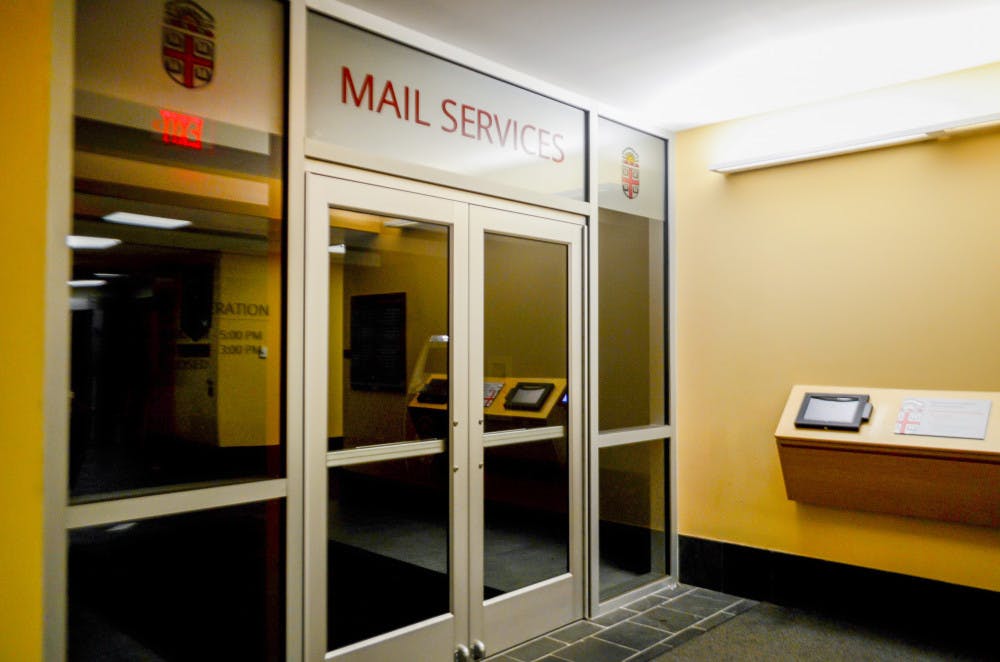As a campus that enrolls students from all 50 states in addition to Washington, D.C., Brown receives many absentee ballots at Mail Services every election cycle. But this year, many students encountered problems after requesting an absentee ballot from their precinct.
Some students noticed a problem with Mail Services’ notification system, which did not alert them that their ballot had arrived.
Lily Meyersohn ’19 said she requested a ballot in September and began to worry when she had not received it by mid-October. After contacting her county clerk to ensure that the ballot had been mailed, she went to Mail Services and asked an employee at the counter to physically check for her mail. When she received her ballot, it was postmarked Oct. 5, she said.
“It’s kind of irresponsible for them not to be prioritizing election mail,” Meyersohn said, adding that she would prefer for election-related mail to be given priority even if it meant other mail would be processed slower. She also noted that she has never had an issue with Mail Services in the past.
Ryan Lessing ’17 said he requested his ballot from Maryland in early October. He received his ballot later that month when he went to Mail Services after getting an email notification for another piece of mail. He was never notified that the ballot had arrived, Lessing said.
Though the new mail service system has been more efficient than the mailboxes, Lessing said there have also been more consistency issues with letter mail. It would be valuable for Mail Services to conduct a review of the system to identify any issues, he added. Mail Services should also send a campus-wide email, particularly during election seasons, telling students to approach Mail Services employees for help if they suspect that there is a problem. Such efforts will “relieve people’s anxieties,” Lessing said.
Gabriel Buchsbaum ’17 said he realized there was a problem when three weeks had passed and he had not received his ballot from Massachusetts. The county clerk also confirmed that his ballot had been sent. When his family called Mail Services, they discovered the ballot had been in the Mail Services system. Buchsbaum had not received an email notification, and the machines said he had no mail when he swiped his card, he said.
“It would be helpful if they did a better job of checking to see if ballots were processed correctly,” Buchsbaum said.
After hearing about other students who were anxious about their absentee ballots, Buchsbaum made a post in the Class of 2017 Facebook group, he said. In the Oct. 26 post, he suggested that people ask Mail Services employees to check the system.
Though Amy Fifer ’17 said she received an email about letter mail, the machine said there was no mail for her when she swiped her card. Fifer, who requested her ballot from Fairfax, Virginia around August, said she “stressed about it” and “didn’t know what to think” until she approached a Mail Services employee and found it in the system in early November.
“They shouldn’t be making this mistake,” Fifer said. “I have zero faith in their ability to let me know when I have mail.”
Grace Johnson ’19, a Herald columnist, never received her absentee ballot for unknown reasons. She resigned herself to not being able to vote until she learned that Rhode Island permits election-day registration to vote for president and vice president. Though Johnson had been following the Minnesota campaigns, she switched her registration from Minnesota to Rhode Island so that she would be able to vote in the presidential election, she said.
Johnson said she believes that incoming first-years should be aware of the potential problems that can arise with absentee ballots. Those hailing from swing states should be especially careful and aware of their voting process, she added.
Amy Huang ’20, who did not receive her absentee ballot until a week before the election, also said people should stay on top of the process because they may have to “go out of their way” to vote.
But Elizabeth Gentry, assistant vice president of business and financial services, said there is no “pervasive” problem with Mail Services. Though she has heard about the students’ issues with their ballots, she said she does not believe the system is at fault.
Letter mail, which comes in trays, are presorted into numerical order based on box number, Gentry said. They are then transferred to the high-density mail system, which is a room that contains plastic hanging folders for every student. Mail employees use finger scanners to ensure that the mail matches the student’s folder, which has a barcode. Once the barcode is scanned, the scanner beeps, and a notification email is sent to the student, Gentry said. All mail is processed on the same day it arrives, she added.
Gentry said that student issues may be due to human error, which happens in any workplace. With the influx of election-related mail, there may have been more mistakes made, she added.
Though it is difficult to know the breadth of the problem, students interviewed agreed Mail Services should be more careful in the future regardless. A high volume of absentee ballots is a predictable event every two years, and this is a chance for Mail Services to improve upon their system, Lessing said.





